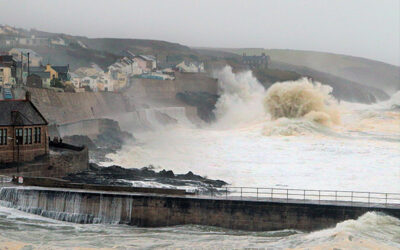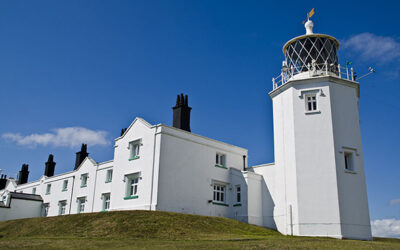The walk between mainland England’s most southerly point, Lizard Point (aka Polpeor), to the turquoise waters and towering islands of Kynance Cove is a must for anyone staying in the area. An easy 2-mile amble along the South West Coast Path, the walk’s gentle gradients and moderate climbs afford some of the country’s most spectacular views.
To start your walk, you can leave your car on the village green or National Trust lighthouse car park and make your way to the Lizard Point. Here, two popular cafes await for a pre-walk ice cream or belly-warming coffee, a nutritional must for any avid walker.
Sufficiently fuelled, from the Lizard Point you turn west (right as you look out to sea) and make your way towards your first destination, Pistol Cove. Crossing a little footbridge, arriving at this picturesque little spot dotted with wildflowers may seem innocuous enough, but you are in fact entering what is believed to be the site of a mass burial.
In this very cove on 25th November 1720, following a fatal run in with submerged rocks out at sea, a military ship called the Royal Anne suffered massive damage and was sucked beneath the churning waves. Tragically, over 200 of the men on board died and, as their bodies washed ashore, locals carried them into Pistol meadow where they would finally lay to rest.
Although the burial hasn’t been confirmed, attempted excavations have been consistently halted as a mark of respect for the sailors. However, while the tale of the Royal Anne is a tragic one, it is by no means unique. All around the Lizard Peninsula’s coast, tales of raging storms and treacherous rocks abound, with over 500 shipwrecks documented and certainly many more unaccounted for.
Leaving Pistol Cove behind, the South West Coast Path makes its way uphill. From here, following the gradual slope of the path you will come to the Old Lizard Head and then onto verdant pastures high above the waves. Looking ahead, the Rill, a craggy headland from where the Spanish Armada were first sighted in July 1588, stick outs like a bony finger into sea. Beyond this, you can just make out Land’s End Peninsula on a clear day.
Following the footpath of trodden grass, the walk continues west and dips into Caerthillian Cove. A lush valley interwoven by two streams, Caerthillian’s green fields roll down to meet the grey and brown hues of exposed earth and rock, before disappearing under a cobalt blanket. At low-tide, rocky platforms protrude from the soft sand, veined with water-worn channels and sheathed in iridescent seaweed.
Once you can tear yourself away from belly of the valley, the path steeply rises and leads you up onto the clifftops once again. Reaching the top, you are immediately rewarded with beautiful panoramic views centred around the iconic Lion Rock. Arguably resembling an enormous squatting frog, Lion Rock bursts from the sea in all 150ft of glory; a true sight to behold and the perfect opportunity to snap a shot for the photo album.
Continuing on, the cliffs skirt Pentreath Beach, 200ft below. Known by some as Boiler Bay, the sea here recedes at low tide to reveal the remains of a large cylindrical ship’s boiler. The boiler, jutting out from the sand, is all that is left of the Maud, a trawler that was being towed from Fleetwood to Hull in February 1912. Sailing into monstrous swells, the Maud was never able to complete its journey and had to be cut loose, sinking to the seabed instead.
Beyond Pentreath, the terrain gently plateaus and gives way to the tufty thickets of the downs. Bony arms of coconut-scented, sunshine-yellow gorse reach out into the track and little birds flitter out of view. Looking left, the views seem to open up and you can really begin to appreciate the sheer scale of the ocean below, as beautiful as it is immense. Now is a good time to slow your pace and savour the last few moments of the walk; you have nearly arrived.
Rounding the next corner, beyond the figure of Lion Rock, the awe-inspiring outlines of Gull Rock and Asparagus Island appear, standing proud amongst turquoise waters. One of the most famous beach scenes in the world, Kynance Cove has become globally recognised for its mesmerizingly clear waters and soaring granite islands topped with vibrant green grass. The fitting end to an unforgettable walk, Kynance Cove is a true paradise and somewhere you’ll be talking about around the dinner table for years to come.




